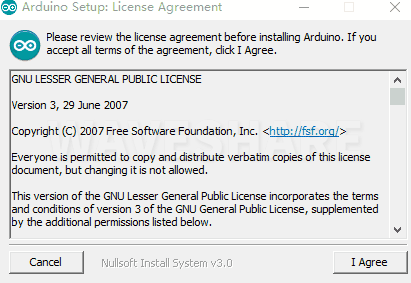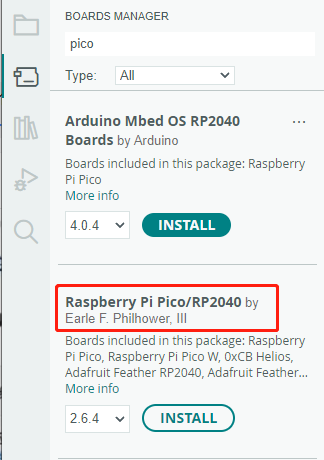Pico Eval Board
| ||
Overview
- A function evaluation board specially designed for Raspberry Pi Pico.
- Rich onboard resources are available to help users get started and learn quickly.
Features
- Standard Raspberry Pi Pico header supports Raspberry Pi Pico series boards.
- 3.5-inch resistive touch screen, 65K colorful, bringing clear and vivid display effect.
- Standard 3.5mm audio jack, for headphones or other audio peripherals.
- Micro SD card slot through the SDIO interface, faster access speed than SPI interface.
- Integrates battery header and recharge circuit, allowing it to keep running without a wired power supply.
- Other rich resources like a buzzer, photoresistor, and RGB LED.
Specifications
| LCD Parameters | |||
| Control Chip | ILI9488 | Resolution | 480 × 320 Pixels |
| Communication Interface | SPI | Display Size | 73.44 × 48.96 mm |
| Display Panel | IPS | Pixel Size | 0.153 × 0.153 mm |
| ICM20948 Parameters | |||
| Accelerometer Characteristics | Resolution: 16 bits Range (optional): ±2, ±4, ±8, ±16g Operating Current: 68.9uA | ||
| Gyroscope Characteristics | Resolution: 16 bits Range (optional): ±250, ±500, ±1000, ±2000°/sec Operating Current: 1.23mA | ||
| Magnetometer Characteristics | Resolution: 16 bits Range: ±4900µT Operating Current: 90uA | ||
Pinout
Video
Dimension
Raspberry Pi
Download Demo
sudo apt-get install p7zip-full -y cd ~ wget https://files.waveshare.com/upload/b/bb/Pico-Eval-Board-Code.zip 7z x Pico-Eval-Board-Code.zip -o./Pico-Eval-Board-Code cd Pico-Eval-Board-Code
- Log in Raspberry Pi terminal by SSH or press Ctrl + Alt + T to open the terminal when using the screen.
- Load and decompress the program to the Pico C/C++ SDK directory, the SDK has not been installed yet. Please refer to the tutorial
C
- Press BOOTSEL on the Pico and connect it to the USB of Raspberry Pi by Micro USB cable.
- Compile and run the c example demo of the Pico-Eval-Board.
cd ./c/
There are corresponding demos in this directory. Different demos correspond to different peripherals and functions.
The following takes 01_GPIO as an example. The GPIO demo will make the LED on the Pico blink every second.
cd ./01_GPIO/build cmake.. make -j #If there is no connection or Pico in download mode will report an error sudo cp ./*.uf2 /media/pi/RPI-RP2/
3. Run the corresponding demo on the Pico.
4. Press the Reset key on the Pico-Eval-Board. Please press the Bootsel key first and the Run key, and then release the Reset key. By now, Pico enters disk mode without plugging or unplugging.
MicroPython
- According to the python environment configuration settings, use the Raspberry Pi desktop system.
- Open the Thonny IDE of the Raspberry Pi system, pull the code file into the IDE, save it to the Pico file system, and click the Run button.
Windows
C
Please refer to Pico.wiki
Download the demo
Use the demo
1. Open the corresponding C program folder:
2. Open it by Vs code and choose the corresponding compile tool.
3. Click "Build" to compile:
4. Press the Reset button on the Pico-Eval-Board to reset the Pico, first press the BOOTSEL button and then the RUN button and then release the Reset button, the Pico can enter the disk mode without plugging and unplugging the Pico, and the UF2 file under the build file Drag and drop to the RPI-RP2 drive letter.
5. At this point, Pico starts to run the corresponding program.
MicroPython
Please refer to Pico-wiki-tutorial
Resource
Document
Driver
Examples
Development Software
Pico Quick Start
Download Firmware
- MicroPython Firmware Download
- C_Blink Firmware Download
Video Tutorial
- Pico Tutorial I - Basic Introduction
- Pico Tutorial II - GPIO
- Pico Tutorial III - PWM
- Pico Tutorial IV - ADC
- Pico Tutorial V - UART
- Pico Tutorial VI - To be continued...
MicroPython Series
- 【MicroPython】 machine.Pin Function
- 【MicroPython】 machine.PWM Function
- 【MicroPython】 machine.ADC Function
- 【MicroPython】 machine.UART Function
- 【MicroPython】 machine.I2C Function
- 【MicroPython】 machine.SPI Function
- 【MicroPython】 rp2.StateMachine
C/C++ Series
Arduino IDE Series
Install Arduino IDE
-
Download the Arduino IDE installation package from Arduino website.
-
Just click on "JUST DOWNLOAD".
-
Click to install after downloading.
-
Note: You will be prompted to install the driver during the installation process, we can click Install.
Install Arduino-Pico Core on Arduino IDE
-
Open Arduino IDE, click the File on the left corner and choose "Preferences".
-
Add the following link in the additional development board manager URL, then click OK.
https://github.com/earlephilhower/arduino-pico/releases/download/global/package_rp2040_index.json
Note: If you already have the ESP8266 board URL, you can separate the URLs with commas like this:https://dl.espressif.com/dl/package_esp32_index.json,https://github.com/earlephilhower/arduino-pico/releases/download/global/package_rp2040_index.json
-
Click on Tools -> Dev Board -> Dev Board Manager -> Search for pico, it shows installed since my computer has already installed it.
Upload Demo At the First Time
-
Press and hold the BOOTSET button on the Pico board, connect the Pico to the USB port of the computer via the Micro USB cable, and release the button when the computer recognizes a removable hard drive (RPI-RP2).
- Download the demo, open arduino\PWM\D1-LED path under the D1-LED.ino.
-
Click Tools -> Port, remember the existing COM, do not need to click this COM (different computers show different COM, remember the existing COM on your computer).
-
Connect the driver board to the computer with a USB cable, then click Tools -> Ports, select uf2 Board for the first connection, and after the upload is complete, connecting again will result in an additional COM port.
-
Click Tool -> Dev Board -> Raspberry Pi Pico/RP2040 -> Raspberry Pi Pico.
-
After setting, click the right arrow to upload.
- If you encounter problems during the period, you need to reinstall or replace the Arduino IDE version, uninstall the Arduino IDE needs to be uninstalled cleanly, after uninstalling the software you need to manually delete all the contents of the folder C:\Users\[name]\AppData\Local\Arduino15 (you need to show the hidden files in order to see it) and then reinstall.
Open Source Demo
- MicroPython Demo (GitHub)
- MicroPython Firmware/Blink Demo (C)
- Official Raspberry Pi C/C++ Demo
- Official Raspberry Pi MicroPython Demo
- Arduino Official C/C++ Demo
Support
Technical Support
If you need technical support or have any feedback/review, please click the Submit Now button to submit a ticket, Our support team will check and reply to you within 1 to 2 working days. Please be patient as we make every effort to help you to resolve the issue.
Working Time: 9 AM - 6 AM GMT+8 (Monday to Friday)





















